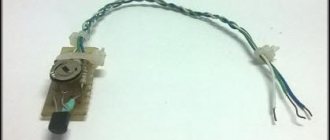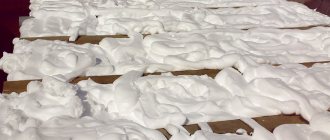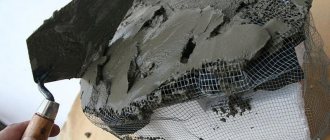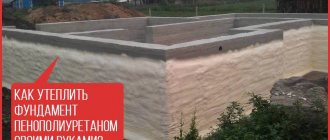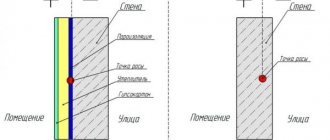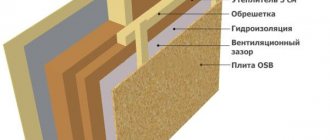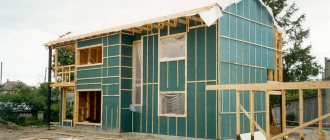Penoizol is considered the heaviest building insulation material available today. You can make penoizol with your own hands, but you can also buy it. Producing penoizol at home is quite simple, and production costs will be lower than purchasing it.
Insulation can be used to decorate not only homes, but also hangars, garages, and other things. With the help of penoizol it is possible to reconstruct old buildings. The product is often used for sound insulation.
Pros and cons of the material
In appearance, the material is very similar to marshmallow: just as white, airy, elastic and porous.
The thick foam mass allows you to insulate a house by filling air spaces in hollow walls and floors, as well as all cracks and crevices. As a result, the mass hardens, turning into porous insulation. (Read this article about the features of insulating a house with foam insulation).
Due to its positive qualities, penoizol has a number of advantages:
- strength, efficiency and durability: the average service life is from 50 to 70 years;
- low thermal conductivity, which allows you to retain heat in the apartment and reduce energy costs;
- versatility: suitable for insulating floors, foaming walls and roofs;
- allows air to pass through, is hygroscopic, the structure of the material “breathes” and does not accumulate moisture;
- fire resistance: the material is not capable of burning; at high temperatures it simply evaporates slowly;
- rodents avoid penoizol, considering it inedible and tasteless;
- prevents the formation of mold and mildew;
- no reactions to organic solvents or chemical exposure;
- environmentally friendly, healthy material.
Disadvantages of penoizol:
- has a tendency to shrink;
- When drying, an unpleasant odor appears, which indicates that the material is of poor quality, and its production technology was violated.
Be careful: when buying penoizol, pay attention to how it smells - high-quality material should not have an unpleasant odor. For comparison, here are some of the disadvantages of a similar heat-insulating material, polystyrene foam:
- flammability;
- the material does not allow air to pass through;
- incompatibility with some materials, for example, wood;
- It is destroyed under the influence of the sun, despite its rigid structure.
These disadvantages once again emphasize the practicality of penoizol.
Interesting fact: expanded polystyrene looks like polystyrene foam, so they are often confused.
In fact, they do have a lot in common and are made from the same material. The only difference is in the technology of their production.
The principle of heat conservation: how does insulation work?
When insulating the surface of walls with liquid polystyrene foam or foam insulation, a heat preservation mechanism operates. To better understand the principle of thermal insulation, here are a few nuances:
- low thermal conductivity is ensured due to the fact that the material is based on only 20% of the binder;
- the holes in the seams between the bricks are filled, thereby retaining heat inside the room;
- Due to the one-piece casting of insulation, a monolithic layer is created, which additionally prevents heat from escaping from the house.
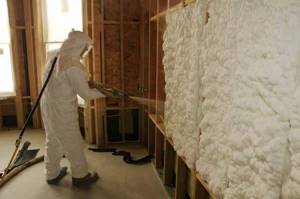
The process of insulating internal walls
Rodents are not able to live in the material; it is not affected by fungus and mold spores. High speed of work is another advantage of using liquid wall insulation. In addition, such material can reduce heating costs. Affordable price, moisture resistance and high sound insulation make the choice in favor of liquid wall insulation a decisive one.
DIY production technology
When ready, the consistency of the mixture is similar to a soufflé. The substance hardens when it comes into contact with air. When applied, this mixture fills all voids. Therefore, the noise and thermal insulation characteristics of the room are improved after foaming the roof and other surfaces.
The material is convenient because work with it can be carried out all year round, regardless of weather conditions. Insulating houses with foam insulation gives the same result.
Types of equipment for do-it-yourself penoizol
Any premises can be used to set up production. But significant savings can be achieved if the process is organized in the same place where construction work is taking place.
The following types of devices are expected to be used:
- compressor;
- Electric Energy;
- pumps for solutions;
- foam generators. Their material matters;
- foam supply pumps;
- steam generator.
All equipment can be easily purchased on the construction market or in specialized stores. Including those working remotely via the Internet.
Devices are produced by different manufacturers, the main differences are in price and characteristics. 35 thousand is the average cost of the overall structure.
Russian and Ukrainian installations in this area give the best results. They are aimed at high-quality insulation of walls with foam insulation.
Equipment necessary for self-insulation
To carry out installation work on insulating the premises, you will need the following mechanisms and equipment:
- Compressor;
- Foam generator;
- Pumps (for supplying solution and for supplying foam);
- Source of electricity;
- Additional fastening and formwork elements;
- Special protection (gloves, glasses, respirator).

Equipment for applying thermal insulation
Features of the material
Penoizol was developed at the end of the 20th century as a modern alternative to polyurethane foam, a proven insulation material that had a number of operational disadvantages. The main difference between the physicochemical properties of penoizol is that it retains its elasticity after foaming. This greatly increases its strength and useful life when insulating and soundproofing loaded structures, such as floors and ceilings. There are other features of the material:
- resistance to changes in temperature and humidity;
- immunity to biological threats: microbes, mold, insects, rodents;
- the fine porous structure promotes high vapor permeability;
- resistance to fire and high temperatures;
- environmental friendliness: does not emit harmful substances even when smoldering.
The elasticity of the material facilitates its installation in sheet form. When sprayed, the high adhesion and penetrating ability of the solution allows you to insulate both large surfaces and hidden cavities and hard-to-reach places.
Separately, it is worth noting the excellent sound insulation. Penoizol copes with both airborne noise and sounds transmitted through building structures.
The production of penoizol does not require special technical knowledge or particularly complex equipment and can be done with your own hands.
The nuances of using foam plastic
Among the wide variety of modern materials, insulation of walls, floors and roof structures with cast foam is a fairly popular procedure. The distinctive feature that sets this procedure apart from others is that there is no need to prepare the surface for these purposes. Transportation of equipment and raw materials to the construction site is carried out by car. The necessary conditions for the facility are the availability of a source of water and electricity.
Direct filling is carried out using a hose, the diameter of which should be 3.0 cm. With its participation, filling can be carried out even in the most remote and hard-to-reach places. The insulation is quite dense and of high quality. It is permissible to apply foam material to an insulated surface.
Insulating walls with this material can be applied to any surface, which will not affect the quality of the work at all. This kind of insulation is also good for filling voids with irregular geometry.
Insulation of walls with foam plastic
The procedure is carried out by pouring it into the space between two walls (external and internal). There are 3 use cases for this technology:
- Pouring into the interwall space of a house in use. This procedure is performed when there is a gap of about 3-5 cm between the surfaces. Holes with d 3.2 cm are formed in the surface in a staggered arrangement and with a distance of 1-2 mm. Then pour the solution under pressure through each hole until it is visible in the hole next to it.
- Pouring into the interwall space of a house under construction. Here the cavity is filled with a solution in several layers. Each layer is no more than 3 meters.
- Filling between false partitions and walls. A false partition can be a finishing coating made of plasterboard, corrugated board, siding, plastic and others. Frame houses are insulated in the same way.
Floor insulation is carried out in the following sequence:
- Holes (diameter approximately 26 mm) are drilled through the boards.
- Through the holes, the internal cavity under the floor is filled with a liquid composition.
- Any foam that comes out is removed.
It is relatively inexpensive and has a sufficient number of advantages in relation to other insulating materials. This modern heat insulator is distinguished by its low weight, simple installation and long shelf life. Thermal insulation of apartments and houses with foam insulation allows you to save the family budget when paying for heating.
Key varieties
There are different types of urea foam. All of them are suitable for thermal insulation of buildings.

Penoizol can be used for thermal insulation of complex structures, interfloor ceilings and floors.
Main types:
- Liquid penoizol. Received the greatest distribution. It can be prepared directly on the construction site, which is why it is very convenient. The material is used for thermal insulation of various structures, as well as for repair purposes. Foam is poured into a confined space to form additional sound insulation in frame buildings. When it comes to repair work, penoizol in liquid form is used to fill cracks and gaps.
- Granular penoizol. It has several names: foam insulation crumb, thermal wool. It is available in the form of elastic granules. During manufacturing, the polymer is crushed into fractions up to 15 mm in size. The volume of the finished material after grinding doubles compared to the original amount. This is a good option to save on installation costs. Granular penoizol is used to fill the cavity between walls and for laying on the floor.
- Sheet foam insulation. The liquid material is poured into a special mold. After cooling, it is cut on special machines or simply by hand until it is given the required thickness. After this, they are dried and mechanically processed. The product is used to insulate buildings under construction. Installation is carried out with dowels from the outside of the walls. Decorative panels or siding are laid on top. In addition, the slabs are laid between the joists on the floor.
More information about the production of penoizol:
Penoizol can have different densities depending on the manufacturer. It varies on average from 6 to 35 kg per cubic meter.
Spray insulation PENOPLEX FastFix 850 ml

Sprayed one-component insulation - a universal one-component polyurethane aerosol spray - is used for insulation of building structures, domestic and commercial premises. Insulation can be applied to any surface, including vertical surfaces and surfaces with a negative slope (inner surfaces of roof slopes, etc.). Ideal for small spaces. It can also be used as an auxiliary insulation for application on uneven and geometrically irregular surfaces, as well as where it is technically difficult to use sheet insulation. Heat resistance (of fully cured adhesive foam) during long-term use: from -45°С to +90°С Area of one cover layer during continuous application (depending on the nature of application), m²: Up to 2.2
PROPERTIES:
- for external and internal work;
- due to its finer-cell structure, it has lower thermal conductivity than polyurethane foam and better insulating properties
- output volume after lifting the cap – up to 55 liters;
- the rise of one layer is up to 2.5 cm. It is recommended to apply in several layers. Apply the second layer only after the first has cured.
- temperature range of use – from -0 to +30 °C (at a cylinder temperature from +10 to +35 °C);
- operating temperature range – from -45 to +90 °C;
- complete curing time – 12 hours;
- after polymerization – chemically neutral, does not emit toxic compounds;
- resistant to mold and fungi;
- excellent adhesion to all surfaces, with the exception of fluorine plastic;
- does not contain ozone depleting substances or solvents.
SCOPE OF APPLICATION:
- insulation of walls, ceilings, roofs, basements, doors, building structures, etc. in premises for economic and domestic purposes;
- as an auxiliary insulation when using insulation from polystyrene foam, basalt, etc.
- ideal for insulating geometrically irregular surfaces;
- sealing gaps between thermal insulation elements;
- spraying on sheet materials to reduce vibrations and for sound insulation.
- can be used for comprehensive insulation of cracks, holes, joints together with mounting foam and mounting adhesive foam
Color: Bright orange.
TECHNICAL CHARACTERISTICS: Density of the finished product after spraying and polymerization, kg/m³ no more than: 16-20
Volume of the finished product after spraying and polymerization, liters: 50-55.
Lifting height of the cap of one layer, mm: Up to 25.
Surface drying time (to touch), min., no more: 15-20.
Curing time, min: About 60.
Complete curing time, hours, no more than: 24.
Time for possible further processing, min., no more: 90.
Thermal conductivity, W/mK: 0.025.
Recommended number of layers when spraying: 1-2.
Fire resistance class (DIN 4102-1): B2.
Technical indicators
Compared to traditional insulation, penoizol has many advantages. The main characteristics worthy of attention include:
- Thermal conductivity. The only low figure is 0.041 W/m/K. To ensure good performance, it is enough to lay a layer 10 cm thick.
- Soundproofing. Noise absorption is at a quite decent level. It is approximately 65%.
- Fire resistance. The flammability group to which penoizol belongs is designated G-1. Its flammability category is B-2. This indicates that it will not melt when exposed to fire. When high temperatures are reached, the material will begin to evaporate, without producing toxic substances. Under the condition of an open fire, 10 times less smoke is generated compared to polystyrene foam.
- Resistant to chemical components. The insulation does not react in any way to aggressive environments. This primarily applies to solvents of organic origin.
- Resistance to humidity. Penoizol has the ability to absorb moisture well, but it gives it away with equal success. The characteristics of the material are not affected. It is capable of absorbing up to 1/5 of moisture. Penoizol subsequently evaporates it. To prevent mold from forming on the wall, install a ventilation gap. The heat insulator absorbs approximately 20% of moisture throughout the day.
- Vapor permeability. The insulation in question is hygroscopic, and therefore allows the walls to breathe. Air circulates freely throughout the structure.
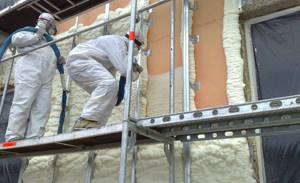
Penoizol has good vapor permeability, which allows the walls to breathe
Other characteristics include biostability. This means that penoizol is not afraid of fungi, pathogenic microflora, and domestic rodents. The material is soft, so it adheres closely to any uneven surfaces. It fills any gaps. With a linear deformation of 9%, the compression strength is 0.5 kg per square centimeter.
They started producing penoizol relatively recently, so we can only talk about its durability. It appeared on the market only 50 years ago. But manufacturers claim that it can last up to 30 years. Environmental friendliness is another advantage, since toxic compounds are not released either during installation or during operation.
Video on how to make a foam generator:
Use in winter
Work in winter is difficult, as problems are created due to low air temperatures. This factor adversely affects the structural composition of penoizol. Approximately 50% of the resin consists of water. For this reason, the viscosity of the material increases. Despite all these unfavorable aspects, penoizol can be poured under certain conditions. Its components must be stored in a warm room at a temperature of at least +15°C, for example in a garage.
The installation must also be placed in a warm place. You can install the cheapest tourist tent for this. The materials must be compactly rolled up, covered with a layer of plastic film, and then the fan heater installed. Before starting work, it is necessary to heat the solution to +40°C, and the resin to +20°C. For this, a regular boiler is used.
More information about do-it-yourself penozol:
If all these rules are followed, you can get penoizol that is no different from the material installed under normal conditions. It is unacceptable to keep it at a temperature below +15°C, as it does not dry well. The moisture it contains will freeze. It will fulfill its role as a heat insulator only with the onset of spring. Moisture that does not freeze in the spring will evaporate by itself. Dry foam will remain unchanged.
Insulation of building envelopes is an important part of the design of a residential building. Walls are no exception, because they account for 25-30% of the total heat loss of a building
Walls are no exception, because they account for 25-30% of the total heat loss of a building.
To achieve the maximum positive effect from work on thermal insulation of a room, it is necessary to choose a high-quality material that has an optimal set of positive properties.
The choice may consist of materials such as:
One of the excellent options may be foam insulation insulation, which we will talk about in more detail in this article.
Scope of application
Penoizol is suitable for insulation and sound insulation of all types of building structures and elements. It is used for elements such as:
- floors and ceilings;
- walls, including frame walls;
- roofs and rafter systems;
- basement floors, foundations and blind areas.
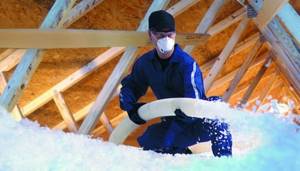
Roof insulation with foam insulation
Sprayed penoizol is perfect for correcting mistakes made at previous stages of construction. It can isolate the so-called. “cold bridges” through which intense heat leaks from heated rooms occur.
In addition to construction, the material is also popular in the production and thermal insulation of refrigeration equipment - from household models to industrial installations.
Separately, it is worth mentioning the use of penoizol as sound insulation in buildings located near highways or in noisy industries. A 50 mm layer of penoizol allows you to reduce the noise level several times and create more comfortable conditions for your stay.
Penoizol is used both for residential premises and for insulating domestic and outbuildings: garages, bathhouses, sheds for keeping farm animals, cellars.
A somewhat unusual area of application for penoizol is firefighting: foam is used to extinguish chemically active substances and energized installations. The sprayed material blocks the access of air and prevents further combustion.
General tips for working with liquid insulation materials
- You should not prepare too much of the composition. It is best to dilute enough product to last for about 25-30 minutes of work. This way you will not lose part of the material due to the latter hardening;
- You can mix the composition to prepare it for work using a drill with a special attachment. However, in this case it is necessary not to exceed the speed of more than 200 rpm. Otherwise, the blades will move too quickly and damage the structure of the granules in the insulation, filling them with water and thus reducing the technical efficiency of the product;
- The wall must be freed from irregularities before work. On sharp irregularities, the insulation layer is thinner than on the rest of the wall surface. Consequently, a kind of “cold bridge” is formed, through which heat flows out of the room very actively. The same goes for cracks on vertical surfaces that a brush or roller cannot handle, and that the material will not fill on its own, as in horizontal cases. Of course, the insulation will cover these problem areas, but after a short time without a base underneath, the layer in this place will crack.
Disadvantages of the product
The main disadvantage of penoizol is that it produces sediment in the range of 0.1−5%. These indicators are better for the material that is between the walls under some pressure. Other disadvantages include:
- Low tensile strength. It's pretty easy to tear.
- Increased moisture absorption. In some situations this is a significant drawback. This feature prevents the use of this type of foam in the underground part of the foundation and when constructing a screed. It is necessary to lay additional waterproofing.
- The need to use special equipment. This is true for liquid forms of foam.
- Installation temperature requirements. It should be above +5°C. High-quality foam will only be obtained if this requirement is met. In addition, liquid urea foam can release phenol-formaldehyde during installation. This is possible if it contains low-quality resin.
How to make polyurethane foam (video)
Today, the place of polystyrene foam, expanded polystyrene and other materials is taken by penoizol. The material is made from inexpensive materials, which during processing are transformed into an effective means for insulating rooms. Penoizol or PEN resembles polyurethane foam in that it easily fills empty space. Penoizol production is a great way to make money. To do this, you always need to develop a business plan and invest money in the necessary equipment. Manufacturing is a great start to a business, comparable in ease to opening a car wash/
Production scheme and necessary ingredients
This inexpensive insulation is not difficult to produce, since cheap composites are used as raw materials. During production, a semi-liquid foam is made. After it hardens, an elastic material is obtained, on which any dents are immediately straightened out.
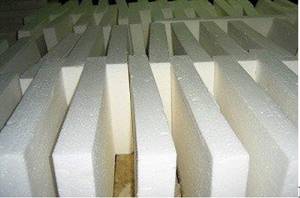
Sheets of finished penoizol
You will need the following ingredients to make penoizol:
- Urea-formaldehyde resin is the substance from which foam is made;
- Phosphoric acid - required for foam hardening;
- Foaming agent;
- Water.
The ingredients for making penoizol are pumped into the unit, where they are mixed and foamed with compressed air. After this, the finished product is supplied under pressure to the area that requires protection from the cold.
Freshly prepared foam resembles white jelly.
The composition hardens in a short time, 10-15 minutes after pumping to the required place from the generator, the foam only slightly sets, reaching full strength after 3 days. The solution will set completely after 1-3 days.

Installation diagram
You need to use a compressor of a certain power.
If you have high-quality foam with small pores, the area of its contact will become larger, as a result the polymerization process will improve. Polymerization is affected by the density of the foam. If the density is not enough (the bubbles will be large), then the foam will quickly settle. If this trouble occurs before the main part of the resin has polymerized, the composition in the mold will simply flow out.
The quality of the foam is affected by the water temperature; if it is low, the material will be of poor quality. There is a concept - foam multiplicity, which shows how much product will be produced from the solution. A high indicator is 60-80, with which you will have 60-80 liters of foam from 1 liter of prepared solution. You can find out this characteristic if you fill a 200 liter barrel with foam and wait until the bubbles disintegrate. Then the completely settled solution is measured. You can increase foaming slightly by adding more foaming agent to the solution.
Selection criteria and equipment purchase
In most cases, liquid penoizol is chosen when it comes to domestic use. It is applied using special equipment. You can rent it to save money.

To apply penoizol, a special installation is required; it can be rented in order to save
To produce penoizol with your own hands at home, you will need to equip the installation. You can arrange it from scrap materials. You will also need a compressor, molds for finished products, and additional equipment for lighting and ventilation. Budget installation options involve a combination of:
- gas-liquid equipment;
- supply hose;
- set of taps;
- plastic barrels;
- compressor.
Urea resins and catalyst are mixed in the plant. They are placed there using a pump. There is compressed air here. The main attention should be paid to the purchase of a pump, since it plays the role of a key element in production. Errors in dosage are especially important. A vortex or plunger pump is the most profitable and effective option. But in any case, foreign particles should not be allowed to get inside, as this will ruin the whole process.
More information about liquid foam:
Types of penoizol
Modern technologies have made it possible to create several types of materials, each of which has its own characteristics and differences. When foaming walls with foam insulation, this is also taken into account.
Liquid
Widely distributed in various spheres of life. A very convenient option due to the fact that it can be prepared directly on construction sites. Helps with repairs, provides protection against heat penetration. To additionally form sound insulation in frame buildings, foam is poured inside a confined space. During repairs, available penoizol helps fill cracks and gaps. It can also insulate.
Granulated
It is also called thermal wool or foam insulation crumbs. Release form: granules with a high degree of elasticity. During manufacturing, the polymer is crushed into fractions, each of which is 15 mm in size.
Compared to the original quantity, the volume of this mixture doubles after such grinding. A good option for those interested in cost-effective installation. Granular penoizol is laid on the floor, and the cavities between the walls are filled with it. The ceiling is easy to process.
Sheet
It involves pouring into a special form, in liquid form. The base is cut on special machines when everything cools down. Or they do everything with their own hands to give the structures the required shape and thickness. Next comes drying with mechanical processing. Insulation of buildings under construction is the main purpose of such materials.
During installation, dowels are used to cover the outer walls. The top of the wall is covered with decorative coverings. Slabs are also laid between the joists on the floor after producing penoizol with your own hands at home.
Comparison with polyurethane foam
The two materials are often compared in terms of financial benefits and technical performance. Safety of use comes first in importance. Manufacturers claim that penoizol is neutral and safe for humans and animals. But at the same time, in a number of states in Canada and America there is a law according to which the use of urea foam for construction is prohibited. It is considered a potential health hazard.
This situation is also observed in some European countries. This is explained by the release of formaldehyde during the polymerization of liquid foam. You can reduce the likelihood of adverse effects by using a vapor barrier on the inside of the wall.
As for polyurethane foam, there are no bans on it in any country in the world. It has all the necessary quality and safety certificates.
In terms of water absorption, polyurethane foam has minimal indicators, since its structure is porous and closed. It retains heat well and is equipped with protection against corrosion, mold and mildew. The appearance of condensation is excluded here. Despite the positive properties of penoizol, excess moisture can lead to its destruction. This can be avoided by installing moisture insulation.
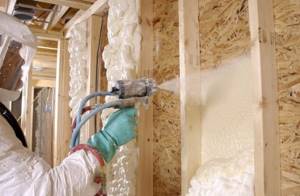
Strong humidity can lead to the destruction of penoizol
In terms of strength and physical and mechanical properties, penoizol is also slightly inferior. It is resistant to mechanical stress, but in this indicator it is still ahead of polyurethane foam. In terms of price, urea foam is an order of magnitude cheaper than polyurethane foam.
Equipment for making penoizol with your own hands
Now they produce many devices for the production of penoizol, among them there is equipment that allows you to make it yourself.
In this case you can:
- Buy a ready-made unit that contains a gas-liquid installation, the necessary set of taps and a hose for supplying foam. In addition, you will need a compressor and containers for a receiver with a capacity of 20-300 liters;
- Make your own device that produces penoizol using ready-made drawings.
Used installations for the production of penoizol are not worth buying. The reason is the wear and tear of the equipment, which will directly affect the quality of the finished insulation. In addition, the seller does not acknowledge the actual condition of the equipment. You can get into a lot of trouble by purchasing a used unit. It's better to buy a new unit right away.
If you decide to use the second option, you will need to find all the components for the production of penoizol:
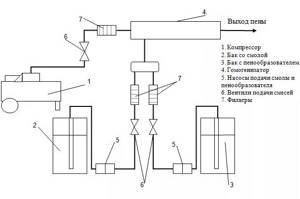
Block diagram of installation of a plant for the production of penoizol
Equipment is divided into construction and workshop equipment. You should remember the important parameters that the installation for penoizol should have:
- Installation of the equipment is not difficult;
- The installation should be easy to use;
- Have the level of performance you require;
- Good mixing of components;
- The ability to change operating parameters is necessary;
- It is better to use equipment that is small in size and lightweight;
- High wear resistance is very important.
Important! When choosing a pump, take into account errors in the dosage of components, possible deviations from engine speed instability as a result of load changes and fluctuations.
Having purchased a package of documents, you can install the unit yourself, and spare parts are easy to purchase.

Foaming device
The design, which contains the most necessary components, will cost you inexpensively:
- Installation for the formation of bubbles in a solution;
- Hose for pumping foam;
- valve;
- Compressor of suitable capacity;
- Available materials;
- Barrels with a capacity of no more than 300 liters.
It is convenient to use vortex or plunger pumps, taking into account the material used in the manufacture of internal parts. It is better if they are plastic, ceramic, stainless steel, or at least plated with nickel.
It is also better to buy a plunger pump designed for pumping foam to the place of self-insulation. The foam is formed at low pressure in a special generator. In this case, double foaming is more effective; the output is semi-dry penoizol, so it will not simply flow out of the cavity. Install one pump to supply resin and a second one to pump foam. along the hose.
The compressor needs sufficient power; when choosing it, resin consumption is taken into account, which should not exceed 25 kg to obtain high-quality material.
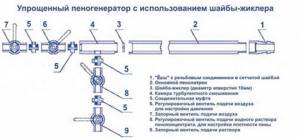
Foam generator diagram
If you need penoizol for your home, then it is convenient to install the equipment directly on the construction site.
First, mix a concentrated mixture of hardener and foaming agent. For 10 liters of concentrate you will need 0.25 liters of orthophosphoric acid and 0.5 liters of foaming agent, all diluted in 10 liters of water heated to 60-80 degrees. The solution is mixed well, when there are no clots or lumps in it, the concentrate is ready, it can be stored in this form for up to 6 months. 1 liter of pre-mixed concentrate is poured into a prepared container of 10 liters of warm water.
Price for liquid polystyrene foam - penoizol.
The cost of raw materials for producing liquid foam - with 10th density at 2021 prices does not exceed 1000 rubles, even taking into account delivery.
Per cubic meter of 10-density
required:
15 l. resins*45 rubles/liter = 675 rubles;
0.085 l. phosphoric acid * 120 rub/l = 10.2 rub;
0.170 l. foam concentrate ABSC * 160 rub/l = 27.2 rub.
Total: 712.4 rub/m3
Per cubic meter of 20-density liquid foam
required:
30 l. resins*45 rubles/liter = 1350 rubles;
0.085 l. phosphoric acid * 120 rub/l. = 10.2 rub;
0.170 l. ABSC foam concentrate * 160 rub/l. = 27.2 rub.
Total: 1387.4 rub/m3
Why do we indicate prices for liters and not for kilograms like all suppliers of raw materials? Everything is very simple - it is easier for the pourer of liquid foam plastic - penoizol to operate with volumes - buckets, liters, barrels, than kilograms - to find which you need scales.
One liter of resin contains 1.3 kg. The usual packaging is 200 liter barrels, approximately 260 kg per barrel.
One liter of phosphoric acid contains 1.75 kg. The usual packaging is 20 liter canisters, 35 kg each.
One liter of foaming agent ABSA contains 1.25 kg. The usual packaging is 20 liter canisters, 25 kg each.
Commercial benefit
Penoizol finds its application in everyday life and commerce. Due to its low cost, this is a very profitable type of business, which involves the production and sale of penoizol in a liquid state or ready-made frozen sheets.
The sale of penoizol does not cause any particular difficulties, such as the process of its manufacture, which is a profitable trump card in the hands of a good entrepreneur.
Watch the video in which the user shares his experience of making penoizol with his own hands:


